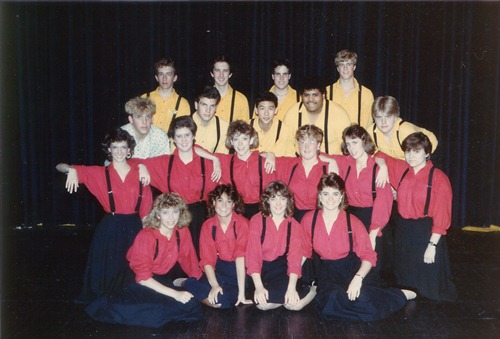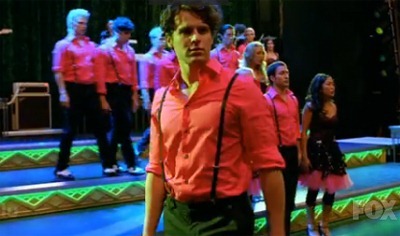Somehow, I've managed to go this long without having done jury duty. I haven't even been summoned in the almost 25 years I've lived in Washington. I did get a summons during college in the Bay Area, but my group didn't need to show up. Finally, last year I received a summons for King County Superior Court. I was actually pretty excited about the opportunity to participate in a jury.
Jury Selection
After deferring the duty once (I was supposed to be there Christmas Eve, the day before our New York City trip), I showed up at the jurors' room in the King County Courthouse in downtown Seattle. There was a huge room full of potential jurors -- easily a few hundred including two friends of mine from Amazon (neither of whom wound up on a jury). We watched a video and then listened to a judge explain how jury duty was the most important way for a citizen to contribute to our system other than military service. We then sat around waiting to see if we'd get called to be a potential juror for a specific judge/court. Fortunately, there was wi-fi and a desk area so I was able to get some work done while waiting.
Then, my name came up along with 49 other people. I received a card with a number on it: 14. More waiting. Finally all fifty of us went to the courtroom of Judge Catherine Shaffer. We learned how to line up by number and file into the courtroom in the right order; we'd eventually get quite good at this. I was surprised that everyone in the courtroom was asked to rise when the jurors came in; I later learned this was because the jurors are officers of the court. Inside the courtroom were Judge Shaffer, her bailiff, court reporter, and courtroom clerk, as well as the prosecutor, the defense attorney, and what I later learned was the defendant.
Judge Schaffer did a great job throughout the process explaining the system; I found it quite interesting and educational. We then spent the next two days in jury selection. This involved a one page written survey (and going back down to the jurors' room). Once back in the courtroom, we were asked a series of questions about our answers on the survey and whether anyone had a reason they couldn't serve. These seemed to fall in a few camps -- upcoming travel, financial difficulty from not working for a few days, and physical issues. She was pretty firm with the travel issues (since those people could have deferred around the travel). She was also pretty binary about the financial difficulty; if serving in the jury meant you couldn't pay your essential bills like rent and utilities, she'd excuse you. Throughout the process, she kept reiterating how important it was to not talk to anyone about the case, not research anything or anyone associated with the case, and to only get information about the case through what was presented in the courtroom. This made total sense, but it was hard not to want to talk about it or look up information on the case and people involved.
We didn't finish the interviews on Monday, and they didn't need to talk to me on Tuesday. On Wednesday, the judge, prosecutor, and defense attorney lead us through a discussion and asked some questions directly -- had you or someone close to you been sexually assaulted, could you imagine finding someone guilty even if there were no physical evidence, could you see past racial stereotypes (the defendant was black) to rule impartially, etc. We started to get a picture of what kind of case this would be. Finally, by mid-afternoon, we knew who was selected. Since I was number 14 and they select 13 jurors (12 plus an alternate -- although who the alternate would be wouldn't be decided until the end of the trial via random selection), I figured it was highly likely I'd get picked. Sure enough, they dismissed a few people ahead of me, so I wound up on the jury.
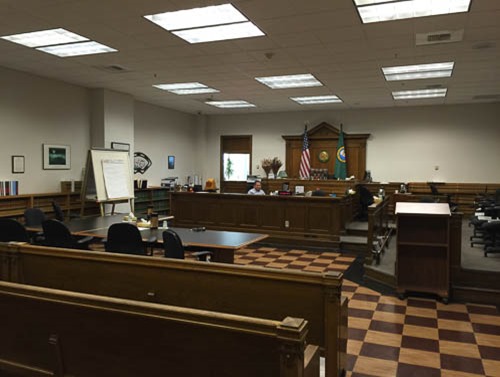
The Trial
The trial started the next Monday. The charge was Attempted Indecent Liberties (an attempt to sexually gratify one's self with someone who is not capable of consenting). The defendant showed up drunk at his ex-sister-in-law's house in Renton at 3:00a. After talking and drinking together, she went to sleep. He allegedly went into the 16 year old daughter's bedroom where she was asleep and pulled down her pajama bottoms. She awoke to feeling pressure and then saw the defendant fumbling with his pants. She went out and woke up her mom. The mom went to her bedroom, got out a rifle (a scoped .303 -- a pretty big hunting rifle) and chased the defendant out of the house. The daughter was the one who called 911, afraid that her mom was going to shoot her uncle. The police showed up pretty quickly then took the mom and daughter to Harborview Hospital. The daughter was checked out, but since there was no penetration, they didn't test for things that might have left DNA. The daughter talked to a social worker there too.
The prosecutor and then the defense attorney made their opening remarks. I thought the prosecutor laid out a pretty clear story. The defense attorney was a little more dramatic (overly so IMHO) and was clearly trying to inject doubt into our minds. Then the prosecutor started calling his witnesses. He called two King County deputies first. They didn't remember much from the case since it happened 2.5 years ago, but once they saw the reports they filed, they remembered more. The defense cross examined a little, but this whole part was mostly non-eventful to me (although I was amazed they had both been working in the King County Sheriffs for over 30 years). He then called the mother. She seemed pretty tough -- not afraid and very straightforward about her opinions. During cross examination by the defense, she started getting visibly mad, which I think may have been the attorney's intent.
We then heard from the daughter. She was understandably nervous and shy about talking about what happened, especially around the details of the contact. At a few points, I could see a tear rolling down her cheek. The defense tried to inject some doubt about the story by showing inconsistencies in the different reports from the police and social worker about what side of her body she was sleeping on. However, the daughter kept having to hold her fingers up in the "L" shapes to figure out which side was left and right; she admitted she confused the sides a lot, but she was very clear she was facing the wall. (We had a photo of her bedroom for reference.) After seeing this, I wasn't surprised by the inconsistencies in the report.
The next day (Tuesday) we heard from the detective who handled the case and the social worker (one of them might have testified on Monday, I don't recall now). The detective didn't impress me much, but the social worker's testimony was consistent with what we had heard earlier. The defense didn't call any witnesses; in particular, the defendant did not testify. Judge Schaffer reminded us that the defense has no burden to prove anything, that the defendant doesn't have to testify, and that the fact the defendant didn't testify was not evidence of anything. We broke early for lunch then came back for closing arguments and instructions from the judge. Again, I thought the prosecutor did a good job tying the story together while the defense mostly just tried to create reasonable doubt, reminding us that even if the evidence was clear and convincing, meeting the bar of beyond a reasonable doubt needed in a criminal trial like this one was a higher standard. The bailiff drew a number out of a box to pick which of us was the alternate juror. He was then excused. (I would have been a little bummed to get picked as the alternate at that point; I'd have wanted to get the whole experience.)
The Deliberation
The jurors filed into the adjoining jury room around 3:00pm or 3:30 and sat around the table. We quickly selected a jury foreman, a young guy who had been through law school but wasn't a practicing attorney. I'm not sure who suggested him, but since no one else really seemed to want to be the foreman, he accepted the role, which was mostly to run the discussion and keep things moving.
I went in thinking the verdict was pretty clear but was willing to listen to the others. I figured this would go quickly and that we might even finish before the courtroom closed up at 4:30. However, everyone wanted to be deliberate and hear each person's view; I thought this was fair and tried not to let my desire to wrap up quickly affect things. It seemed most people were leaning toward guilty, but then one guy started proposing a pretty wild theory, that the mom didn't like the defendant and made up the whole thing to frame him, that maybe the defendant was never even in the bedroom. He wasn't sure at all that the defendant was guilty. We had to leave for the day with this theory still out there.
We came back Wednesday morning. The guy with the wild theory had thought about it a lot overnight and realized it was a little far fetched vs. the testimony. We discussed the case for about another 45 minutes. At this point I tried to move us to consider the three things that had to be proven for a guilty verdict: that the defendant had taken substantial steps toward committing an act of indecent liberty, that he had an intent to commit this act, and that the act took place in Washington State. We voted on each pretty quickly (with only one speech about how a guilty verdict would probably ruin the defendant's life), unanimously agreeing on a guilty verdict. We had to wait about 40 minutes for the attorneys and defendant to come back to hear the verdict. We filed in, the judge read our verdict, and then we each had to answer to the judge whether this was our vote individually and that this was the decision of the entire jury. The defendant had been pretty stoic through whole trial, but he was shaking his head a little after the judge read the verdict. I'm very confident we made the right decision, but I couldn't help but feel a little bad for the guy. His life will never be the same again.
Somewhat surprisingly, we each received a certificate recognizing our service. (Sentencing happens later and doesn't need us.) Then, as we left the courtroom, the prosecutor and defense attorney were waiting outside. The judge had told us they might want feedback, but since they didn't stop me to ask, I left. My duty was done.
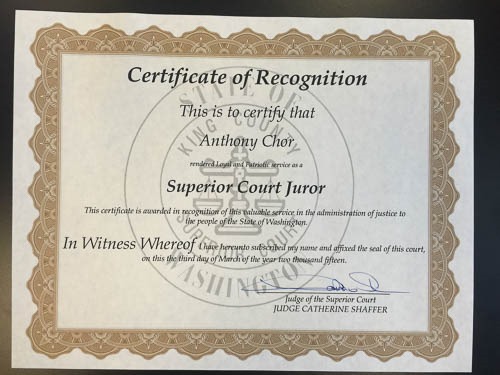
Some thoughts
Overall, I was impressed with the process and especially Judge Schaffer. As I mentioned, she explained things well to the jurors. She was also clearly concerned about everyone's comfort, even bringing in pastry and bagels for us each morning.
Before coming, I was concerned about crazy, illogical people in the jury. There were certainly more non-sequitors and logical mistakes during the discussion than I'm used to in my meetings at Amazon or Microsoft, but the deliberations were mostly on topic and rational, modulo the one crazy theory. My fellow jurors seemed able to separate their personal experiences out and only consider what was presented as evidence.
The biggest hassle about the process was the lack of predictability around time. Each potential juror is called for either two days or the length of one trial. I blocked out time on my calendar at work, but I wound up going into the office on Tuesday, Thursday, and Friday the first week but then back in court on Monday through Wednesday the next week. There was also a lot of waiting around at the courthouse, first in the main jurors' room and then in our jury room. The days were shorter and slower paced than my normal work day.
While I don't think it played a role in this case, I would have liked the jury to be more diverse. There was only one woman out of the thirteen of us. There was one black man (maybe two -- I wasn't clear about one guy) and three Asians. The rest were white men. Other than gender, this might actually map pretty well to Seattle's demographics, but it still looked pretty unbalanced.
I was surprised that the bailiff was a law clerk, not a sheriff. The bailiff's role is to keep the court running smoothly and serve as a liaison with the jurors. I guess I watch too much TV. The whole trial was not like TV, in fact. I knew this going in, but it was still a little surprising how matter-of-fact and almost mundane most of it seemed.
One nice perq was having 90 minutes for lunch in a different area of town. I got a chance to visit some of my favorite places that I don't normally get to visit -- in particular Salumi (opened by Mario Batalli's dad, they make sandwiches from their house-made salamis -- awesome) and Mike's Noodle House (good Hong Kong-style noodle and congee joint).
I'm glad I got a chance to do this (and that it was a short case). It's definitely worth doing.


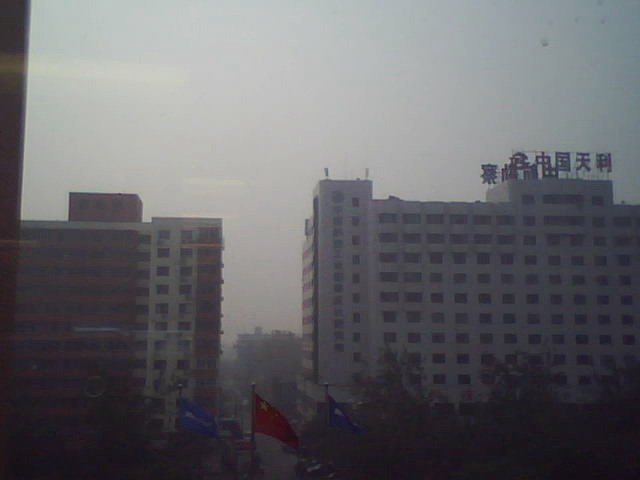
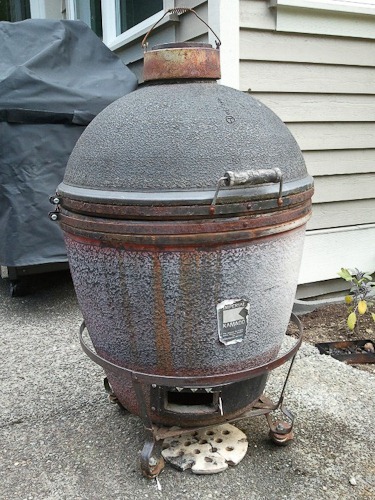
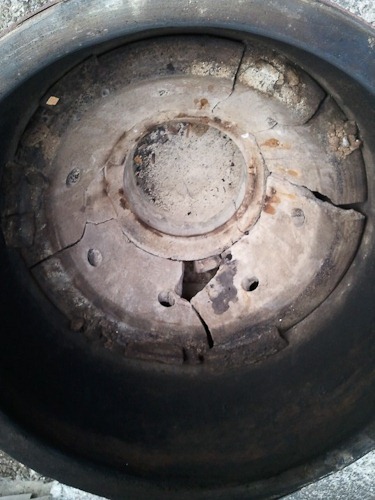
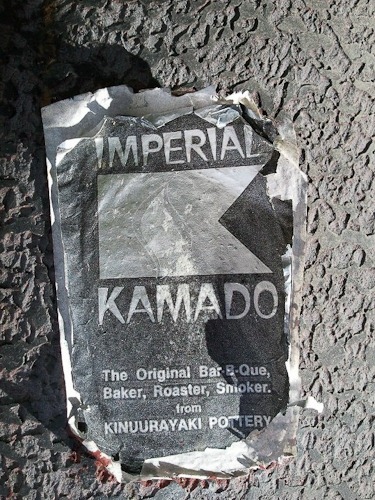
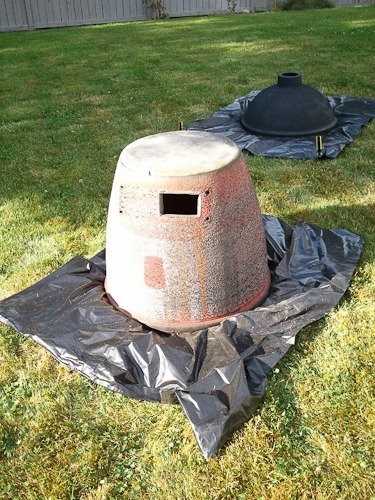
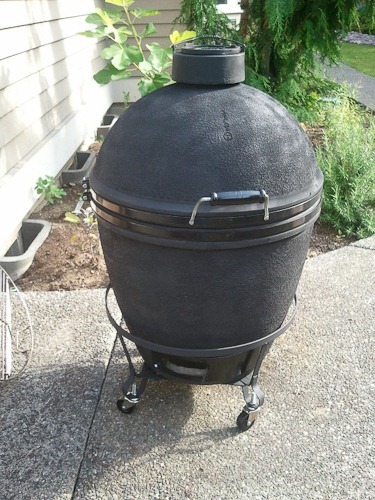
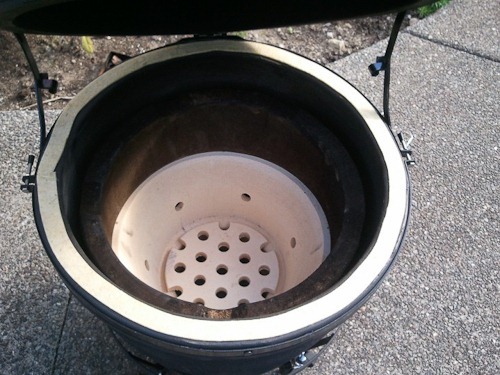
_3a4305a6-b9f6-4a21-9aab-d4f0f5e8513b.jpg)
